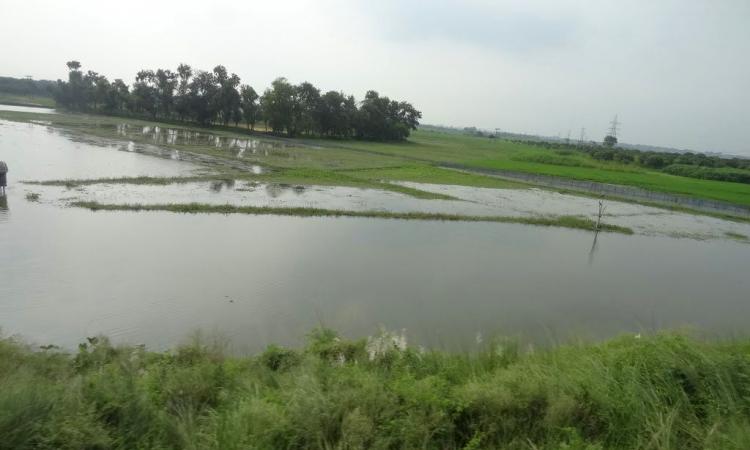
In the active floodplain area of River Ganga in Eastern India, channel migration and flooding is very common. It is called the Diara region. In the southwest portion of West Bengal's Malda district, after passing the Rajmahal hills River Ganga begins its lower course. India-Bangladesh international border has constrained this region on the south-eastern side.
The three rivers Ganga, Kalindri and Mahananda have enclosed this fertile floodplain from the west, north and east side respectively. The region also has two rivers that are almost stagnant - Pagla and Bhagirathi. Flood and wetlands are very much common in this region as a result.
This area is home to nearly 42 major wetlands, along with numerous water patches. Diara occupies about 880 sq. km of area and in the Bengal District Gazetteer, it has been described as a physiographic region where physical stability is maintained by the interplay of rivers (Lambourn, 1918).
As the left bank of River Ganga is considered as the western boundary of this region, the shifting of River Ganga has made the boundary very dynamic. In between 1926 and 2016, River Ganga has produced about 855.55 sq. km. of migration corridor that has led to the loss of 210 sq. km. area from this region (Mukherjee and Pal, 2017).
In a recent study ‘Hydrological and landscape dynamics of floodplain wetlands of the Diara region, Eastern India’ by Kaustuv Mukherjee and Swades Pal, the floodplain wetland dynamics of the Diara region, an active floodplain region of River Ganga has been assessed in three key dimensions - spatial, hydrological, and landscape ecological.
Wetland dynamics research primarily concentrates on individual wetland’s loss or gain of the area where landscape specific approach is majorly ignored. This study highlights how landscape-specific approaches instead of individual wetland-specific strategies if adopted, might help better interpret the wetland scenario.
This is more so in the case of floodplain wetlands which depend largely on the actions of the parent rivers such as increased flow, channel migration path, flooding events, channel cut-offs and other events that are episodic in nature.
Centroid method, hydro-period analysis, water presence, threshold dependent NDWI-NDVI are the key methods used for spatial and hydrological dynamics. A new method of Mean NDWI-NDVI Depth (MNND) has been introduced to measure the hydrological change in the wetlands.
Few major landscape ecological metrics have been calculated using FRAGSTATS and lastly, the forest fragmentation rules are adopted to divide the wetland landscape into the patch, edge, perforated and core areas.
The result shows that wetland dynamics are very much unpredictable and strongly influenced by the behaviour of the River Ganga. The wetland area has significantly gone up to 12095.37 ha in 2011 from 6795.9 ha in 1991 due to the massive flood of 2010 and again it has gone down to 5725.35 ha in 2019.
In 2019 the wetland centroid location has moved 2.14 km away from the 1991′s centroid location in the opposite direction where River Ganga exists.
Most of the wetlands here are heavily fragmented into smaller patches that account for only 10 percent of core wetlands. Thus the vast portion of the floodplain wetlands can be degraded at any time due to hydrological instability, severe fragmentation and over-dependence on episodic events like floods.
This research has portrayed all the probable avenues of wetland dynamics study which can demonstrate the overall change that took place in the wetland landscape. This work is also a very simple representation of wetland spatio-temporal changing scenarios that can be applied by any other researchers in other areas.
Seven sample years have been taken to perform the quantitative assessment of spatial, hydrological, landscape ecological and fragmentation dynamics of this lower Gangetic floodplain region.
River Ganga and its magnitude of discharge have a tremendous impact on the Diara region and its wetlands. A severe flood can drastically enhance the hydrological stability of the wetlands and at the same time, prolonged non-flood can deteriorate the condition. So, the dynamic behaviour of the wetlands is majorly dependent on the local extreme hydrological phenomena.
Heavy monsoon and inundation is turning out to be healthy for the wetlands. On the other hand, the water areas being too fragmented are extremely susceptible to loss. The lower share of core and perforated areas also lead to poor stability of these wetlands. Hence, the ecological benefits that any floodplain wetlands can provide are getting reduced due to such degradation.
This flood-prone Diara region needs more stable wetlands to prevent the damage caused by the flood but instead either they are getting fragmented or converted into the non-wetland areas. It leads to further degradation and as a result, only 10 percent of the wetland area is now highly stable.
Therefore, proper attention is needed to prevent the loss and degradation of the wetlands. Besides, the focus should be given to maintaining the optimum hydrological condition of the existing wetlands. It is recommended that the planners and decision-makers should take proper initiatives in conserving the wetland landscape of this region as a whole instead of single-site approach.
The full paper can be accessed here
/articles/floodplain-wetlands-diara-region-facing-degradation